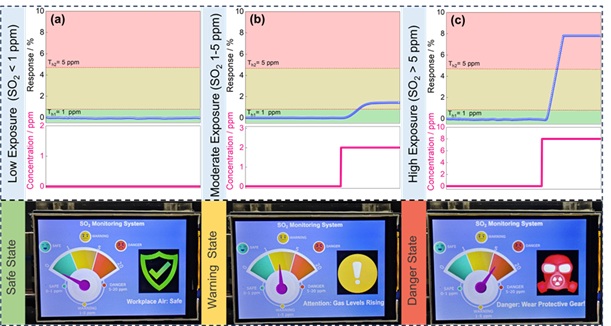New pocket-sized sensor can detect a silent threat in the air
New pocket-sized sensor can detect a silent threat in the air
A new low-cost sensor can help detect toxic sulfur dioxide (SO2) gas responsible for respiratory irritation, asthma attacks, and long-term lung damage, at extremely low concentrations.
SO2 is a toxic air pollutant commonly released from vehicles and industrial emissions, and even minute exposure can cause serious health issues and long-term lung damage. It is hard to detect before it has an adverse effect on health. Monitoring SO2 levels in real-time is crucial for public safety and environmental protection, yet existing technologies are often expensive, energy-intensive, or unable to detect the gas at trace levels.
To overcome this, scientists from Centre for Nano and Soft Matter Sciences (CeNS), Bengaluru, an autonomous institute of Department of Science and Technology (DST), fabricated a sensor by combining two metal oxides — nickel oxide (NiO) and neodymium nickelate (NdNiO3), through a simple synthesis process. While NiO acts as the receptor for the gas, NdNiO3 serves as the transducer that efficiently transmits the signal, enabling detection at concentrations as low as 320 ppb, far surpassing the sensitivity of many commercial sensors.

Fig: Threshold-triggered sensor response in a) Safe state, b) Warning state, and c) Danger state.
To demonstrate the capabilities of this material, the team led by Dr. S. Angappane developed a portable prototype that incorporates the sensor for real-time SO2 monitoring.
The prototype features a straightforward threshold-based alert system that activates visual indicators, green for safe, yellow for warning, and red for danger, allowing easy interpretation and response, even by users without scientific expertise. Its compact and lightweight design makes it suitable for use in industrial areas, urban locations and enclosed spaces where continuous air quality monitoring is necessary. With its high sensitivity, portability, and user-friendly operation, this sensor system offers a practical solution to monitor and manage SO2 pollution, supporting public health and environmental safety. This work demonstrates the potential of material science to create accessible technologies for real-world challenges.
The sensor was designed by Mr. Vishnu G Nath, with contributions from Dr. Shalini Tomar, Mr. Nikhil N. Rao, Dr. Muhammed Safeer Naduvil Kovilakath, Dr. Neena S. John, Dr. Satadeep Bhattacharjee and Prof. Seung-Cheol Lee. The research has been published in the journal Small.